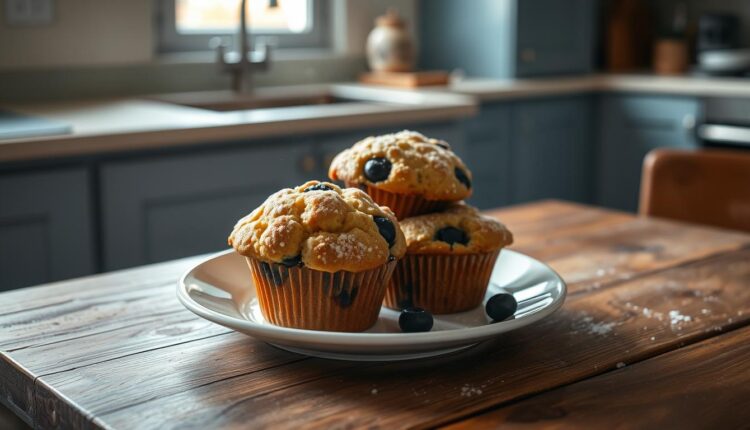Make Ahead Breakfast Gluten Free For Celiac Safety
Start your day right with our make ahead breakfast gluten free guide. Learn how to prep healthy, delicious meals in advance
I’ll never forget the first time I realized meal prep could be more than leftovers. Years ago, during a hectic week juggling work deadlines and a kid’s soccer tournament, I grabbed a batch of savory muffins from my freezer. One bite of those egg-packed, veggie-loaded gems—and suddenly, breakfast wasn’t a scramble. It was a quiet victory.
For those managing celiac disease, mornings demand more than speed. They require trust. Cross-contamination risks hide everywhere, and “quick fixes” often come with hidden dangers. That’s why having safe, ready-to-eat options matters—not just for convenience, but for peace of mind.
This guide shares kitchen-tested recipes that honor both flavor and safety. You’ll find savory casseroles you can portion into airtight containers, protein-rich bowls that reheat in minutes, and yes—those life-saving muffins. (My secret? Three Baker’s 7 Ancient Grains bread adds nutty depth without gluten.)
We’ll walk through smart storage practices, pantry swaps that prevent accidents, and how to build a rhythm that turns Sunday prep into weekday freedom. Because you deserve mornings where the only thing you’re rushing toward is your first cup of coffee.
Getting Started with a Make-Ahead Gluten Free Breakfast
Picture this: It’s 6:47 AM, and your kid’s lunchbox sits empty. Your coffee’s cold. But instead of panic, you reach for a jar of pre-whisked eggs and chopped veggies. That’s the power of intentional prep—it turns chaos into calm confidence.
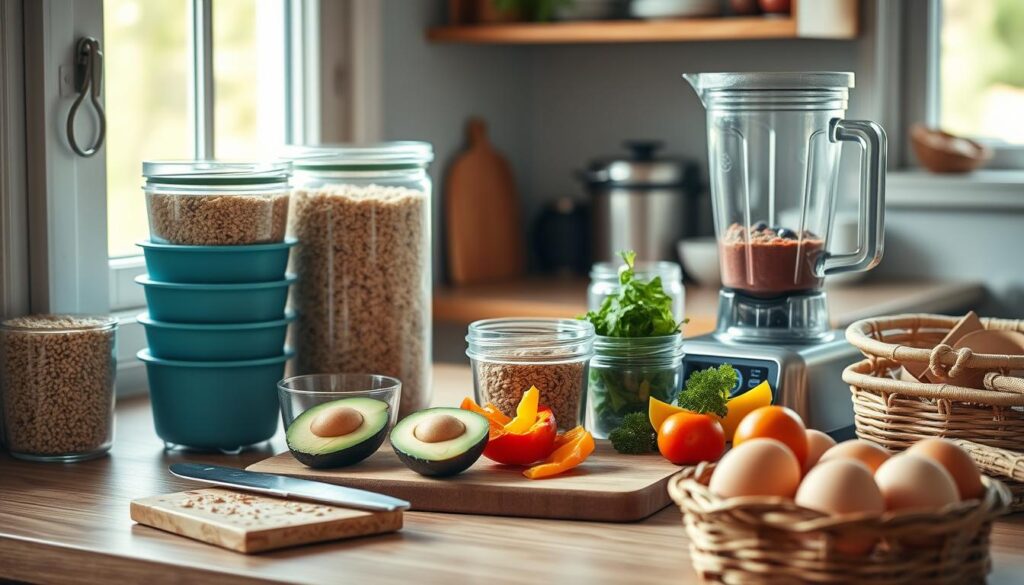
Your Kitchen, Your Safe Zone
Celiac safety starts with control. I learned this after accidentally using a contaminated spoon years ago. Now, I:
- Store dedicated gluten-free tools in red containers (my visual cue)
- Wipe surfaces twice before mixing batters
- Label every container with dates and ingredients
These steps take minutes but prevent days of recovery. Always check labels—even spices can hide sneaky additives.
Why Morning You Will Thank Evening You
Sunday prep isn’t about perfection. It’s about stacking small wins. My go-to breakfast meal prep system uses three basics:
- Protein-packed bases (think quinoa or chickpea flour)
- Pre-chopped flavor boosters (caramelized onions freeze beautifully)
- Portion-controlled add-ins (measured in cups for consistency)
Last week, I batch-cooked sweet potato hash in my large skillet while roasting chickpeas. Wednesday’s rushed meal? A savory scramble with crumbled bacon—ready in 90 seconds.
Pro tip: Keep a notebook by your stove. Jotting notes like “1/4 tsp salt better than 1/8” helps refine recipes without guesswork. Your future self deserves that clarity.
Nutritional Benefits and Health Advantages
Let me tell you about the morning my spinach-packed frittata changed everything. Halfway through a chaotic workweek, I noticed something—I wasn’t reaching for mid-morning snacks. The combination of proteins and vitamins in that dish kept me fueled longer than my old cereal routine. That’s when I truly understood how intentional eating transforms energy levels.
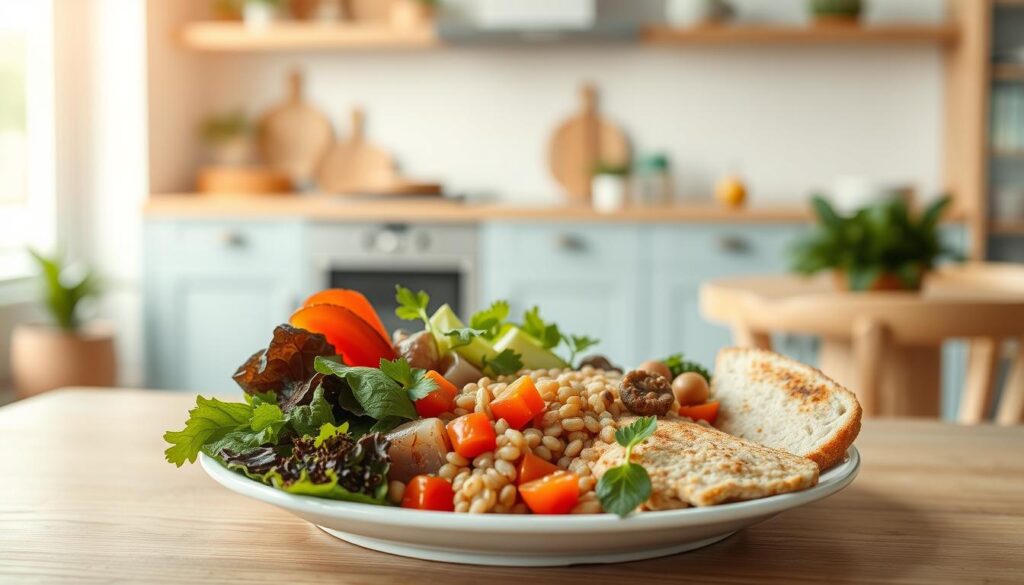
Key Vitamins and Proteins in a Gluten-Free Diet
Eggs are my kitchen’s MVP. One muffin packs 6g of protein from eggs, plus B12 for focus. Turkey sausage adds iron—a nutrient many celiac warriors lack. And here’s a trick: a dash of pepper doesn’t just spice things up. It helps your body absorb iron more efficiently.
Cheese lovers, rejoice! Cheddar in breakfast casseroles delivers calcium and vitamin D. I once swapped it for a dairy-free alternative and missed that creamy texture. Now I stick to sharp cheddar—its bold flavor means I use less, keeping portions smart.
The Role of Carbohydrates and Fats in a Balanced Meal
Carbs aren’t the enemy—they’re fuel. Gluten-free oats in muffins provide sustained energy, while avocado oil offers heart-healthy fats. Compare that to traditional toast: many store-bought gluten-free breads spike blood sugar faster. My solution? Pair them with proteins like eggs to slow digestion.
| Recipe | Proteins | Key Vitamins | Carbs | Fats |
|---|---|---|---|---|
| Savory Muffins | 12g | B12, D | 18g (oats) | 9g (avocado oil) |
| Sausage Casserole | 22g | Iron, Calcium | 14g (sweet potato) | 12g (cheddar) |
When shopping, I scan labels for hidden sugars in gluten-free products. A client once showed me her office-friendly breakfasts—pre-portioned frittata cups with a 3:1 protein-to-carb ratio. Genius! Now I aim for that balance in every batch.
Planning Your Breakfast: Ingredients and Prep Essentials
There’s a quiet magic in opening your fridge to find exactly what you need. Last month, I nearly burned a batch of egg bites because I grabbed baking soda instead of powder. Now I keep my staples organized in clear jars—a simple fix that saves time and sanity.
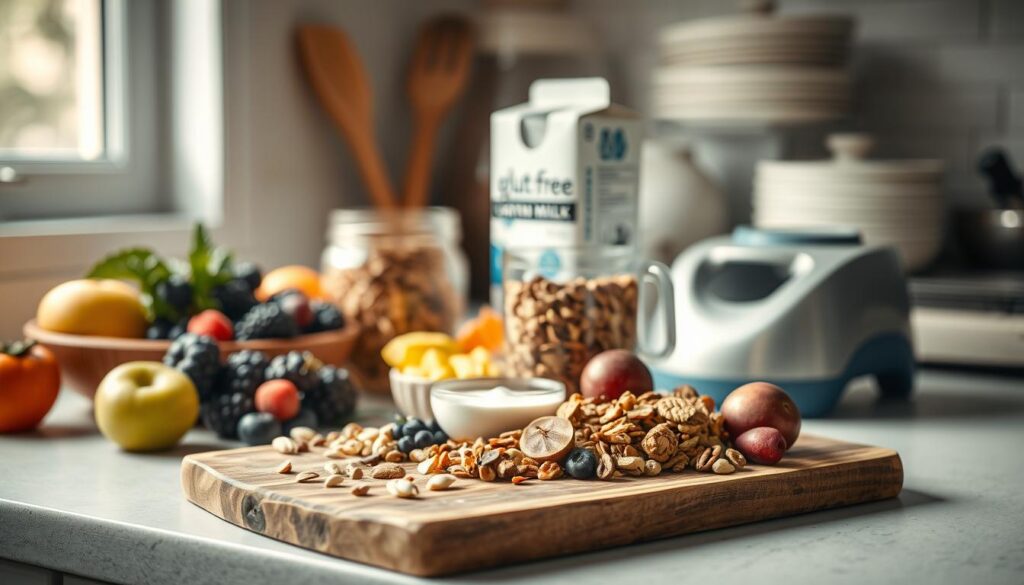
Essential Pantry Staples and Gluten-Free Alternatives
Start with certified gluten-free oats and breadcrumbs. I prefer turkey sausage over pork—it’s leaner and pairs well with sharp cheddar. Red bell peppers add sweetness without overpowering dishes. Always have dairy-free milk on hand; almond works in most recipes.
Precision matters. Use measuring cups for dry ingredients like chickpea flour. A teaspoon of salt can transform bland mixes. Pro tip: Let cooked onions cool slightly before adding eggs. This prevents curdling and improves texture.
| Staple | Use Case | Swap Option |
|---|---|---|
| Gluten-free bread | Croutons for casseroles | Quinoa flakes |
| Dairy-free milk | Whisking eggs | Coconut cream |
| Turkey sausage | Protein boost | Lentils (for plant-based) |
Choosing the Right Equipment for Meal Prep
Invest in a heavy large skillet—it distributes heat evenly for caramelizing onions. I use two baking dishes: one for savory muffins, another for casseroles. Preheating your oven to 350°F ensures consistent results.
Glass containers with lids stack neatly. Label them with dates using chalk markers. Remember: Good tools don’t need to be expensive. My favorite spatula cost $3 and has flipped hundreds of omelets.
How to Make Ahead Breakfast Gluten Free
My kitchen disaster turned triumph happened on a rainy Tuesday. I’d forgotten to grease the muffin tin properly—again. But that sticky mess taught me the value of methodical prep. Now, I approach recipe assembly like building layers of trust: each step protects your time and health.
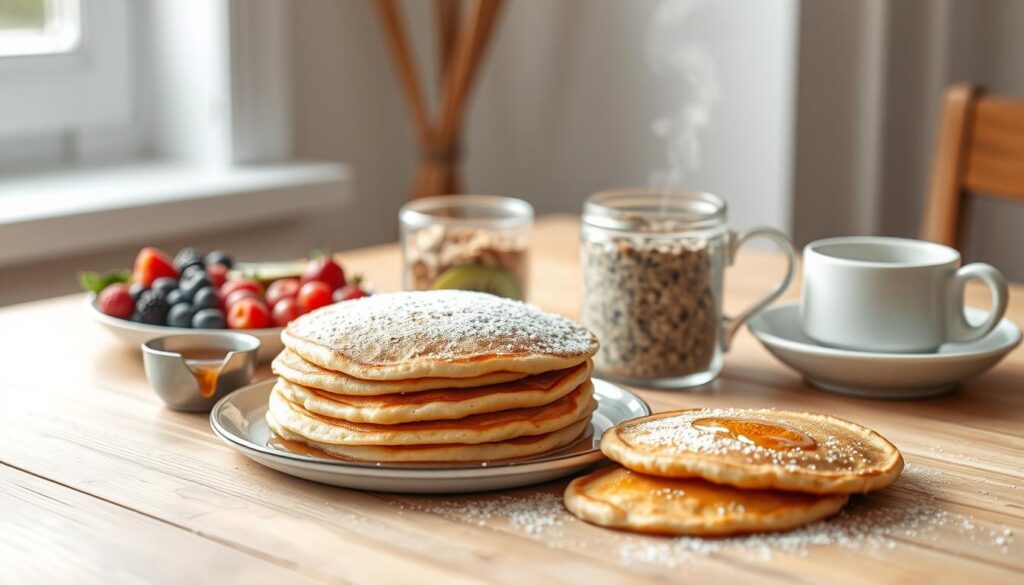
Step-by-Step Recipe Assembly and Cooking Tips
Start by heating your oven to 350°F—this consistent temperature prevents uneven baking. Grab your skillet and brown ½ pound of turkey sausage over medium heat. (Crumbling it with a wooden spoon ensures perfect texture.) Drain excess fat using a paper towel-lined plate—this balances richness without sacrificing flavor.
Whisk 8 eggs with ¼ cup dairy-free milk in a large bowl. Add 1 teaspoon garlic powder, ½ teaspoon salt, and a pinch of pepper. Fold in cooled sausage and ¾ cup shredded cheese. Pour into greased muffin cups or a casserole dish lined with gluten-free bread cubes.
Adapting Recipes for Muffins, Casseroles, and Bowls
Muffins need structure. Add ¼ cup chickpea flour to the egg mixture for lift. Casseroles thrive on layers: hash browns first, then protein, veggies, and cheese. For bowls, cook quinoa separately and top with reheated sausage mix.
| Format | Base Ingredient | Protein | Cooking Time | Storage |
|---|---|---|---|---|
| Muffins | Egg mixture + veggies | Turkey sausage | 22 minutes | Freezer-safe bags |
| Casserole | Gluten-free bread | Black beans | 35 minutes | Glass containers |
| Bowls | Quinoa or rice | Rotisserie chicken | 10 minutes | Mason jars |
Skillet pro tip: Let it cool slightly before adding eggs. Cast iron holds heat intensely—a quick wipe with oil prevents sticking. Those extra minutes you spend prepping today? They’ll gift you calm mornings all week.
Exploring Recipe Variations and Creative Ideas
Last winter, I discovered caramelized onions could turn basic egg bites into something extraordinary. That’s the beauty of meal prep—your favorite recipes evolve with your cravings. A few smart swaps can transform familiar dishes into exciting new experiences.
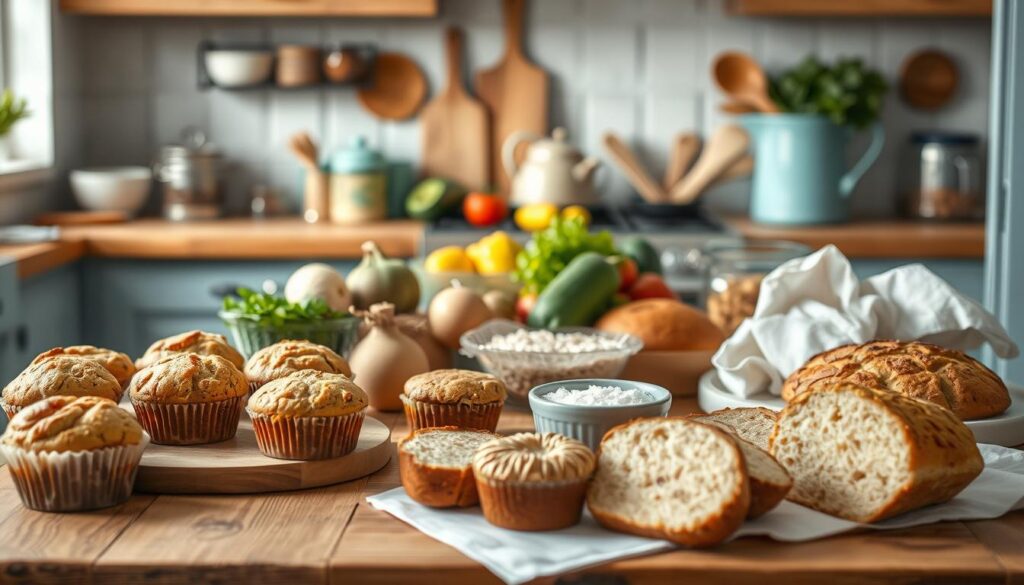
Flavor Enhancements with Veggies and Cheeses
Roasted red bell peppers add sweetness to casseroles, while sautéed onions bring savory depth. Try smoked cheddar instead of mild varieties for a bold twist. My neighbor once swapped turkey sausage for crumbled bacon in her breakfast bowls—now it’s her family’s most-requested dish.
For texture contrast, fold in broccoli florets or diced zucchini. A pinch of pepper flakes elevates simple combinations. Need inspiration? Try this formula:
- Base: 6 whisked eggs or 2 cups chickpea flour batter
- Crunch: ½ cup chopped veggies (bell peppers work great)
- Cheese: ¼ cup shredded sharp cheddar or dairy-free alternative
Customizing Recipes for Different Dietary Needs
Hosting friends with varied diets? Build modular meals. Prepare a base casserole without dairy, then offer cheese toppings separately. For plant-based versions, swap eggs for silken tofu blended with nutritional yeast.
| Dietary Need | Protein Swap | Flavor Boost |
|---|---|---|
| Dairy-Free | Coconut milk | Smoked paprika |
| Low-Fat | Turkey bacon | Lemon zest |
| Vegan | Mashed lentils | Turmeric |
Portion individual servings in mason jars for grab-and-go convenience. Top reheated bowls with fresh herbs or avocado slices. Remember—your meal prep should serve your life, not the other way around.
Storage, Freezing, and Reheating Best Practices
Three years ago, I ruined a perfect frittata by reheating it straight from frozen. The edges turned rubbery while the center stayed icy. That mistake taught me what truly matters: how you store and warm food impacts safety and satisfaction.
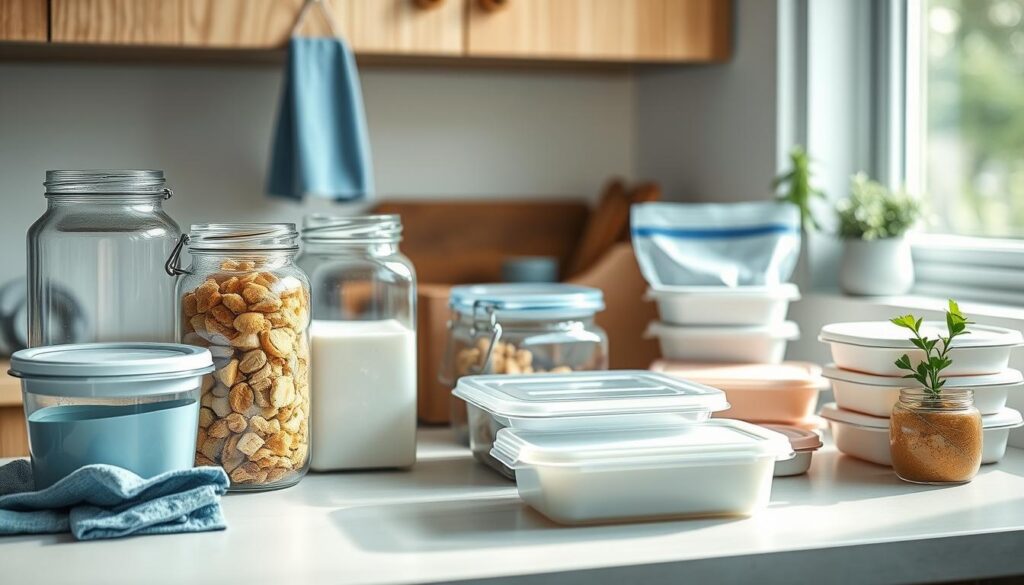
How to Safely Store Your Make-Ahead Meals
Let cooked dishes cool slightly—about 15 minutes—before covering. Trapped steam creates condensation that breeds bacteria. For casseroles, I slice portions first. Why? Reheating individual squares takes fewer minutes than thawing a whole pan.
My freezer strategy:
- Use glass containers or silicone molds for muffins
- Wrap egg bites in parchment before plastic wrap
- Label with “Eat by” dates using chalk markers
Pro tip: Freeze breakfast bowls in wide-mouth jars. They stack neatly and transition from freezer to microwave safely.
Effective Techniques for Reheating Without Compromise
Microwaves are convenient but tricky. Always start at 50% power for 90 seconds, stir, then full power in 30-second bursts. For oven 350°F reheating, place casserole slices on a rack over a baking sheet. This circulates heat evenly.
| Method | Time | Best For |
|---|---|---|
| Microwave | 2-3 minutes | Single portions |
| Oven | 12-15 minutes | Casseroles, muffins |
| Skillet | 5 minutes | Hash bowls |
Never skip the temperature check. A food thermometer should read 165°F for egg dishes. Your free breakfast deserves that crispy-edge perfection without the risk.
Remember that rushed Tuesday when your coffee went cold? Now imagine opening your fridge to find ready-to-reheat egg bites or a savory casserole waiting. That’s the power of intentional prep—it turns chaos into calm nourishment.
Through trial (like my slightly charred turkey sausage experiment), I’ve learned three truths. First: quality ingredients matter. Pasture-raised eggs pack protein. Sharp cheddar adds richness without excess. Second: balance creates staying power. A dash of pepper boosts iron absorption, while measured cups of dairy-free cream prevent recipe mishaps.
Most importantly? Flexibility fuels consistency. Swap caramelized onions for roasted peppers in your bowl. Try smoked gouda instead of cheddar in muffins. Jot notes on what works—was ¼ teaspoon salt better than ½? These tweaks build confidence.
Whether you’re baking a veggie-loaded casserole or assembling grab-and-go jars, every recipe here honors your time and health. Because mornings shouldn’t start with stress—they should launch you into the day feeling prepared, safe, and curiously excited for that first bite.
Zesty Turkey and Quinoa Breakfast Casserole Cups
These savory, freezer-friendly breakfast cups combine lean turkey, fluffy quinoa, and bright bell peppers for a gluten-free breakfast that reheats beautifully and fuels you for hours. Ideal for batch prep and stress-free mornings.
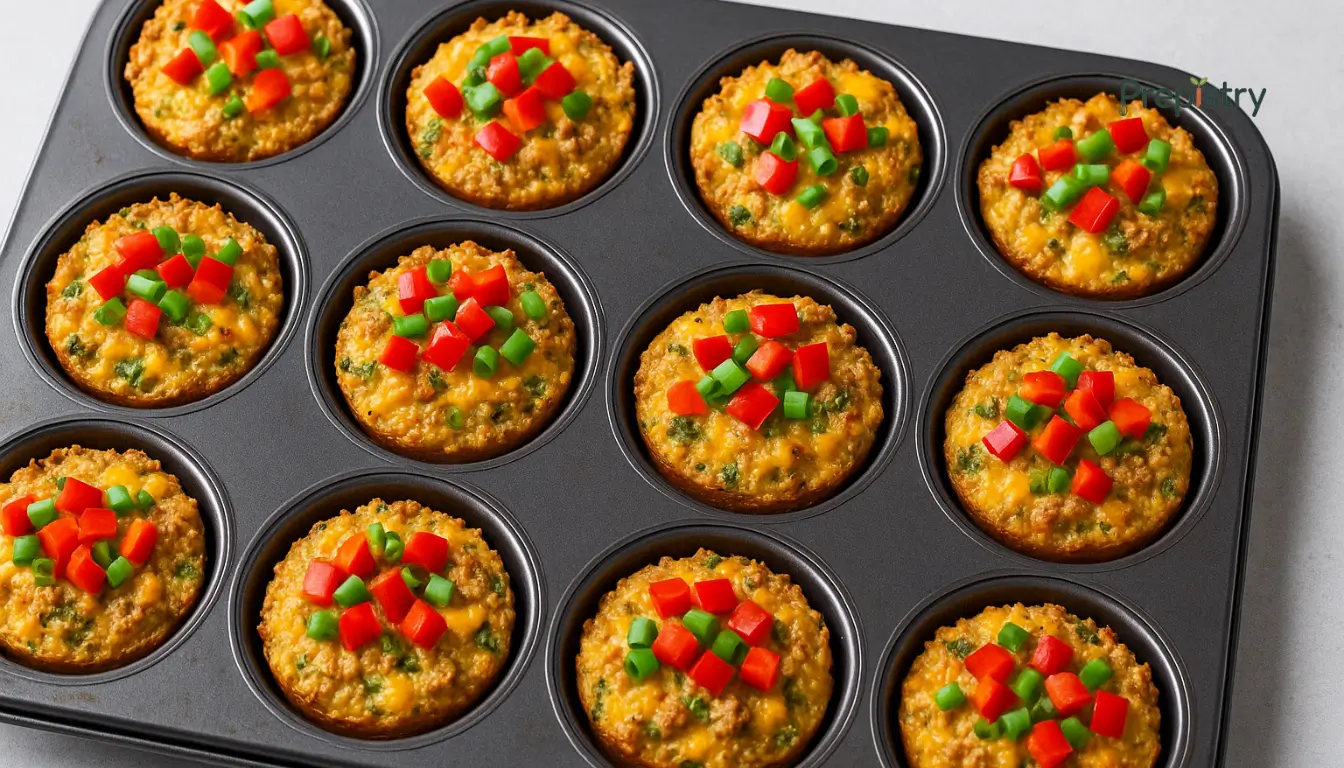
Nutrition Information
Equipment Needed
- Large skillet
- 12-cup muffin tin
- Mixing bowls
- Whisk
- Measuring cups and spoons
Ingredients
-
1/2 lb ground turkey (lean, gluten-free certified)
-
1 cup cooked quinoa (cooled)
-
6 large eggs
-
1/4 cup unsweetened dairy-free milk (almond or oat)
-
1/2 cup shredded sharp cheddar or dairy-free cheese alternative
-
1/2 cup diced red bell pepper
-
1/4 cup chopped green onions
-
1 tsp garlic powder
-
1/2 tsp smoked paprika
-
1/2 tsp salt
-
1/4 tsp black pepper
-
Olive oil spray (for greasing muffin tin)

